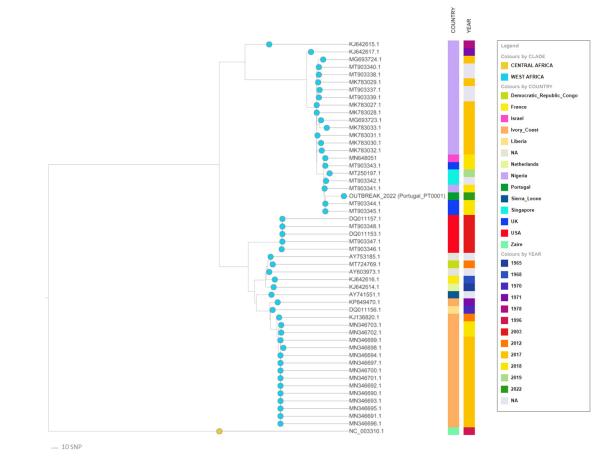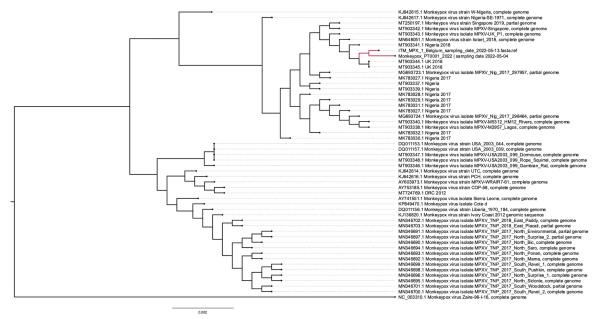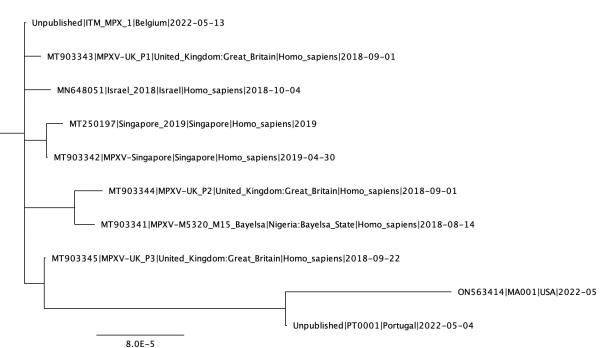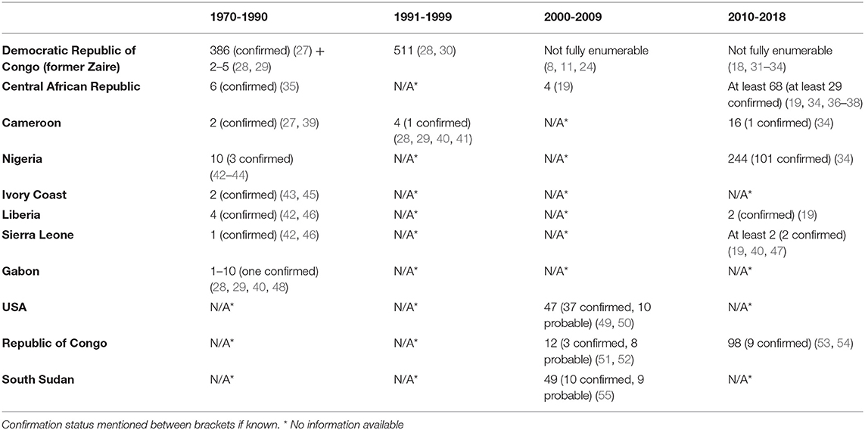
As of May 21, three research groups from Portugal, Belgium, and the United States have released the preliminary results of the genome sequences of the viruses carried by infected persons in the recent monkeypox (Monkeypox) outbreaks in many places around the world. The DNA sequences of three monkeypox viruses (MPXV) initially showed homology, all belonging to a mild West African strain, which were closely related to monkeypox viruses discovered in the United Kingdom, Singapore and Israel in 2018 and 2019.
The World Health Organization has previously stated that there are two main branches of monkeypox virus: the West African branch and the Congo Basin branch. The West African clade has a lower fatality rate, with about 1% of infections resulting in death; the Congo Basin clade can cause a 10% mortality rate.
According to the latest statistics from the World Health Organization, as of May 21, 129 non-monkeypox-endemic countries have reported 129 confirmed and 28 suspected cases of monkeypox to WHO, and the number of confirmed cases of monkeypox globally is expected to continue. Increase.
Monkeypox usually begins with flu-like symptoms and swollen lymph nodes, and symptoms are often similar to, but milder than, smallpox. Early symptoms include fever, muscle pain, chills and fatigue. In more severe cases, a rash usually appears on the face and genitals, similar to chickenpox and smallpox. Painful and itchy lesions can form throughout the body, eventually becoming crusted and sloughed off.
People infected with monkeypox usually begin to experience symptoms 7 to 14 days after infection, and the condition usually lasts for several weeks. Both the World Health Organization and the U.S. Centers for Disease Control and Prevention declare that "while most people recover from the virus, in some cases it can be dangerous and even fatal."
On May 19, local time, João Paulo Gomes of the Portuguese National Institute of Health and his colleagues published the team's May 4 in the form of a paper on the website (https://virological.org). Draft genome sequencing of a monkeypox virus carried by a Portuguese male patient (PT0001). This is also the first sequencing result of the latest monkeypox virus genome since the recent outbreak of monkeypox in many places around the world.
The team used the QIAamp DNA blood kit (Qiagen) to extract monkeypox virus DNA from patient skin exudate samples and shotgun the viral genome on the Oxford Nanopore MinION platform using the Rapid Barcode Sequencing Kit (SQK-RBK004). Metagenome sequencing. The average depth of coverage across the genome is about 7-fold. (Depth of coverage, also known as sequencing depth, refers to the average number of times each base is sequenced, that is, the ratio of the total amount of data sequenced to the size of the genome.) Then, the team used the INSaFLU online platform to map multiple short gene fragments (reads) onto a relevant reference genome sequence (MN648051.1) and manually check the genome sequence to verify the location of the variant. The published draft genome sequence covers 92% of the reference sequence.
As of May 19, Portugal has confirmed more than 20 cases of monkeypox, and researchers have initiated genome sequencing of several virus samples. "The data and analysis will be further updated as more viral genomes are sequenced, which has important implications for elucidating the origin and international spread of viruses that are currently circulating," said the authors of the paper.
Belgium's sample report was released on May 20, local time. Researchers from the University of Antwerp in Belgium published their report on (www.virological.org) on the genetic sequencing of the virus carried by a monkeypox patient in the country. The Belgian male case was 30 years old and had a history of sojourn in Lisbon, Portugal. Perianal papules and painful enlargement of bilateral inguinal lymph nodes presented to the ITM Sexually Transmitted Infections Clinic. His partner later developed similar symptoms. Preliminary investigation of samples taken from the lesions showed negative results for herpes simplex virus and Treponema pallidum, and positive for monkeypox virus.
Subsequently, the researchers used non-targeted metagenomics methods to obtain monkeypox virus whole genome sequence data on Oxford Nanopore's minION platform, reconstructing 98.9% of the genome, with an average sequencing depth of 18.9 times.
The third monkeypox virus genome sequencing report (MA001) was published by American researchers. On May 20, local time, a research team in the United States announced the genetic sequencing results of the virus carried by a monkeypox patient diagnosed in Massachusetts on May 18. The current data results are only published in the database of the National Library of Medicine, and no related articles have been published publicly. (https://www.ncbi.nlm.nih.gov/nuccore/2241461119)
Andrew Rambaut, an evolutionary biologist at the University of Edinburgh in the United Kingdom, compared the three draft gene sequences and commented:
"Compared to the 2018 UK_P3 (UK) genome, the MA001 (US) and PT0001 (Portugal) genome sequences share many of the same nucleotide variations, some of which are plausible, but since they were both sequenced on the Nanopore platform obtained, so may contain a systematic artificial error of the platform. The Belgian (ITM_MPX_1 genome) may differ from this clade - it is at such a bottom position in this tree, which is unusual, and, in many of the n The location is different from ma001 and PT0001."

He also said that further sequencing with deeper coverage will improve the creation of consensus genomes of outbreak strains, but caution should be exercised when interpreting these initial genomes, other than mapping the genetic tree of the 2017-2019 clade.
Is this outbreak caused by a single variant of the virus?
According to the introduction of SCI Medical Network, monkeypox virus is a species of orthopoxvirus belonging to the Poxviridae family, and has the typical form of orthopoxvirus. The morphology is consistent with the orthopox virus, the shape is rounded brick or oval, and the size is 200nm~400nm. The monkeypox virus genome is double-stranded DNA, about 197 kb in length, containing an identical but opposite inverted terminal repeat at the end of the genome. In terms of physicochemical properties, monkeypox virus is between smallpox virus and vaccinia virus. Resists ether, has strong resistance to drying, but is easily inactivated by chloroform, methanol and formalin. Heating at 56°C for 30 minutes is also easy to inactivate it.
Humans have been dealing with monkeypox viruses for more than half a century. The virus was first identified in a population of research monkeys in 1958, and the first human case of the virus was detected in the Democratic Republic of Congo in 1970. But before this unusual monkeypox outbreak in many countries around the world, most monkeypox infections occurred in Central and West Africa.
From September 2017 to April 2018, the largest recorded human monkeypox outbreak in West Africa occurred in Nigeria. The outbreak has seen a total of 244 cases, including 101 confirmed cases, geographically spread across Nigeria's 25 states and the Federal Capital Territory, with 6 deaths (case fatality ratio 2.5). Statistics from September-December 2017 showed that the cases were predominantly male (75%), aged 21-40 years (median 30 years). The original cluster of cases (two brothers, their uncle and a neighbor) became ill after killing and eating monkeys captured by a neighbor's house.
In 2018, there were three cases of monkeypox in the UK, and a person returning to the UK from Nigeria infected two other members of their family. The first monkeypox case in Europe this year was also diagnosed in May after returning to the UK from Nigeria.
New Scientist (www.Newscientist.com) magazine recently commented that the current monkeypox epidemic is the largest of its kind outside Central and West Africa. As more virus samples are sequenced, researchers may be able to conclude The conclusion is whether a single variant of a monkeypox virus caused all cases in the most recent outbreak.
"But it's not easy to determine whether this variant is unique." Even in the now well-studied new coronavirus, it is difficult to link specific mutations to changes in aspects such as the virus's ability to spread. The monkeypox virus has a huge genome—about 200,000 base pairs, compared with 30,000 for the coronavirus—that scientists haven't studied that deeply.
The World Health Organization has previously stated that there are two main branches of monkeypox virus: the West African branch and the Congo Basin branch. The West African clade has a lower fatality rate, with about 1% of infections resulting in death; the Congo Basin clade can cause a 10% mortality rate.
According to the latest statistics from the World Health Organization, as of May 21, 129 non-monkeypox-endemic countries have reported 129 confirmed and 28 suspected cases of monkeypox to WHO, and the number of confirmed cases of monkeypox globally is expected to continue. Increase.
Monkeypox usually begins with flu-like symptoms and swollen lymph nodes, and symptoms are often similar to, but milder than, smallpox. Early symptoms include fever, muscle pain, chills and fatigue. In more severe cases, a rash usually appears on the face and genitals, similar to chickenpox and smallpox. Painful and itchy lesions can form throughout the body, eventually becoming crusted and sloughed off.
People infected with monkeypox usually begin to experience symptoms 7 to 14 days after infection, and the condition usually lasts for several weeks. Both the World Health Organization and the U.S. Centers for Disease Control and Prevention declare that "while most people recover from the virus, in some cases it can be dangerous and even fatal."
On May 19, local time, João Paulo Gomes of the Portuguese National Institute of Health and his colleagues published the team's May 4 in the form of a paper on the website (https://virological.org). Draft genome sequencing of a monkeypox virus carried by a Portuguese male patient (PT0001). This is also the first sequencing result of the latest monkeypox virus genome since the recent outbreak of monkeypox in many places around the world.
The team used the QIAamp DNA blood kit (Qiagen) to extract monkeypox virus DNA from patient skin exudate samples and shotgun the viral genome on the Oxford Nanopore MinION platform using the Rapid Barcode Sequencing Kit (SQK-RBK004). Metagenome sequencing. The average depth of coverage across the genome is about 7-fold. (Depth of coverage, also known as sequencing depth, refers to the average number of times each base is sequenced, that is, the ratio of the total amount of data sequenced to the size of the genome.) Then, the team used the INSaFLU online platform to map multiple short gene fragments (reads) onto a relevant reference genome sequence (MN648051.1) and manually check the genome sequence to verify the location of the variant. The published draft genome sequence covers 92% of the reference sequence.

Figure 1: The draft gene evolutionary tree analysis published by the Portuguese team is based on a core alignment including 52 monkeypox virus gene sequences (955 variant positions were aligned in the 137 668 bp length of the gene sequence)
According to the paper, a draft genetic tree analysis revealed that the isolated virus was closely related to the virus that spread from Nigeria to the UK, Israel and Singapore in 2018 and 2019. The authors of the paper say that once the high-depth Illumina data is available (sequencing is still in progress), the viral genome sequence will be further presented.As of May 19, Portugal has confirmed more than 20 cases of monkeypox, and researchers have initiated genome sequencing of several virus samples. "The data and analysis will be further updated as more viral genomes are sequenced, which has important implications for elucidating the origin and international spread of viruses that are currently circulating," said the authors of the paper.
Belgium's sample report was released on May 20, local time. Researchers from the University of Antwerp in Belgium published their report on (www.virological.org) on the genetic sequencing of the virus carried by a monkeypox patient in the country. The Belgian male case was 30 years old and had a history of sojourn in Lisbon, Portugal. Perianal papules and painful enlargement of bilateral inguinal lymph nodes presented to the ITM Sexually Transmitted Infections Clinic. His partner later developed similar symptoms. Preliminary investigation of samples taken from the lesions showed negative results for herpes simplex virus and Treponema pallidum, and positive for monkeypox virus.
Subsequently, the researchers used non-targeted metagenomics methods to obtain monkeypox virus whole genome sequence data on Oxford Nanopore's minION platform, reconstructing 98.9% of the genome, with an average sequencing depth of 18.9 times.

Figure 2: The gene evolution tree of monkeypox virus published by the Belgian team
The researchers said that by rapidly aligning the newly sequenced genome with the core regions of the protein-coding regions of previously published genomes, they found that the Belgian monkeypox virus genome (ITM_MPX_1) also belongs to the West African branch of monkeypox virus, which is similar to the recently uploaded Portuguese The outbreak genomes are most closely related, further evidence that there is substantial community transmission in Europe.The third monkeypox virus genome sequencing report (MA001) was published by American researchers. On May 20, local time, a research team in the United States announced the genetic sequencing results of the virus carried by a monkeypox patient diagnosed in Massachusetts on May 18. The current data results are only published in the database of the National Library of Medicine, and no related articles have been published publicly. (https://www.ncbi.nlm.nih.gov/nuccore/2241461119)
Andrew Rambaut, an evolutionary biologist at the University of Edinburgh in the United Kingdom, compared the three draft gene sequences and commented:
"Compared to the 2018 UK_P3 (UK) genome, the MA001 (US) and PT0001 (Portugal) genome sequences share many of the same nucleotide variations, some of which are plausible, but since they were both sequenced on the Nanopore platform obtained, so may contain a systematic artificial error of the platform. The Belgian (ITM_MPX_1 genome) may differ from this clade - it is at such a bottom position in this tree, which is unusual, and, in many of the n The location is different from ma001 and PT0001."

Figure 3: Gene evolution tree of monkeypox virus compiled by Andrew Lambert

Figure 4: Alignment of nucleotide variants in monkeypox virus genome samples
"Previously, we estimated that the genome of variola virus (a relative of monkeypox, also belonging to the genus Orthopoxvirus) has about 1x10-5 substitutions per locus per year, which would result in an average of 1-2 nucleosides per year in the virus Acid changes. That's on the high end of the estimate. Yet monkeypox viruses probably didn't evolve at exactly the same rate," said Andrew Lambert.He also said that further sequencing with deeper coverage will improve the creation of consensus genomes of outbreak strains, but caution should be exercised when interpreting these initial genomes, other than mapping the genetic tree of the 2017-2019 clade.
Is this outbreak caused by a single variant of the virus?
According to the introduction of SCI Medical Network, monkeypox virus is a species of orthopoxvirus belonging to the Poxviridae family, and has the typical form of orthopoxvirus. The morphology is consistent with the orthopox virus, the shape is rounded brick or oval, and the size is 200nm~400nm. The monkeypox virus genome is double-stranded DNA, about 197 kb in length, containing an identical but opposite inverted terminal repeat at the end of the genome. In terms of physicochemical properties, monkeypox virus is between smallpox virus and vaccinia virus. Resists ether, has strong resistance to drying, but is easily inactivated by chloroform, methanol and formalin. Heating at 56°C for 30 minutes is also easy to inactivate it.
Humans have been dealing with monkeypox viruses for more than half a century. The virus was first identified in a population of research monkeys in 1958, and the first human case of the virus was detected in the Democratic Republic of Congo in 1970. But before this unusual monkeypox outbreak in many countries around the world, most monkeypox infections occurred in Central and West Africa.

From September 2017 to April 2018, the largest recorded human monkeypox outbreak in West Africa occurred in Nigeria. The outbreak has seen a total of 244 cases, including 101 confirmed cases, geographically spread across Nigeria's 25 states and the Federal Capital Territory, with 6 deaths (case fatality ratio 2.5). Statistics from September-December 2017 showed that the cases were predominantly male (75%), aged 21-40 years (median 30 years). The original cluster of cases (two brothers, their uncle and a neighbor) became ill after killing and eating monkeys captured by a neighbor's house.
In 2018, there were three cases of monkeypox in the UK, and a person returning to the UK from Nigeria infected two other members of their family. The first monkeypox case in Europe this year was also diagnosed in May after returning to the UK from Nigeria.
New Scientist (www.Newscientist.com) magazine recently commented that the current monkeypox epidemic is the largest of its kind outside Central and West Africa. As more virus samples are sequenced, researchers may be able to conclude The conclusion is whether a single variant of a monkeypox virus caused all cases in the most recent outbreak.
"But it's not easy to determine whether this variant is unique." Even in the now well-studied new coronavirus, it is difficult to link specific mutations to changes in aspects such as the virus's ability to spread. The monkeypox virus has a huge genome—about 200,000 base pairs, compared with 30,000 for the coronavirus—that scientists haven't studied that deeply.
Related Posts
0 Comments
Write A Comments